Helen Lowe's Blog, page 318
November 11, 2010
Out of this Eos: It's All About Character!
I'm guest posting on my US publisher's Out of this Eos blog today, talking some more about characters in The Heir of Night, particularly Kalan, the heralds, Jehane Mor and Tarathan of Ar, and the Honor Captain, Asantir. This follows on from an earlier post, in which I focused on Malian, the Heir to the House of Night, and her father, the Earl, as "Characters Under Pressure."
Check it out here.
November 10, 2010
Something About Auckland … Photos and Poem
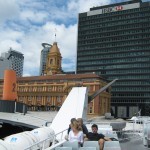
Journey's start; the downtown Ferry Building
OK, here's the photos and the poem. And for all those of you who say—but you haven't mentioned Auckland's traffic yet: no, I haven't. But you see, for me, that's a very long way from being all there is to Auckland and just for the moment, I'm focusing on some of that other, really good stuff. Shocking, I know, for a "one-eyed Cantabrian", but sometimes you just have to call it the way you see it! 
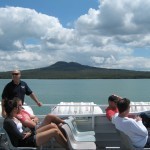
Passing Rangitoto Island
So here's the poem:
—
Something About Auckland
Shelly Bay, Midwinter 2003
There definitely is something
about Auckland,
with the sea lapping in
along a hundred little bays
and blue
shining all the way out
into the Gulf, with its scattering
of islands,
turquoise misting into cobalt
and the sun sparkling
on every wave edge
curving in
to a pohutakawa-tangled
shore — boats bob, voices
calling one to the other
in that last, little rush
of landfall, unexpected echo
of summer.
(c) Helen Lowe
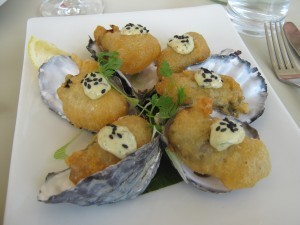
Fine fare at Te Whau
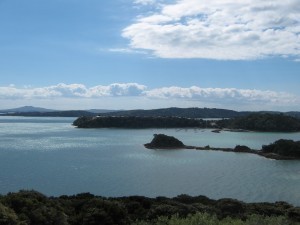
The view from Te Whau, toward Rangitoto and Auckland
Something About Auckland …
Right now I'm in Auckland, which is New Zealand's largest city and built on an isthmus between two harbours, the deep water Waitemata in the east and the large but much shallower Manukau in the west. Beyond the Waitemata is the Hauraki Gulf, which features a number of quite special islands, not least of which is Waiheke, which is an easy 45 minutes ferry ride from the downtown CBD. (Don't entirely believe the weblink though—Waiheke isn't "tropical"; "semi-tropical" would be more correct.) Needless to say, quite a number of people now live on Waiheke Island (including writers and artists) and commute to Auckland. There are also vineyards (almost ubiquitous in NZ these days) and restaurants where one may, if so minded, enjoy a long leisurely lunch.
Yesterday, I did just that, together with a number of other friends and visitors who are here for the same wedding. We caught the ferry and got to enjoy sunshine and sea air, as well as the views out to the other islands of the Gulf and the wonderful shades of blue, from sunlit aquamarine to deep cobalt, of the Gulf waters. We then enjoyed that long leisurely lunch at a vineyard and restaurant called Te Whau, which I can thoroughly recommend, both for the location, the service and the food. Needless to say, a good time was had by all, including wedding guests from the UK, Italy and Spain. And while waiting for the ferry on our way back, we got to see a stingray cruising the (sorry, it's cliche, but …) clear-as-crystal waters beside the wharf—just 45 minutes from the downtown CBD. Wonderful.
A few years back I wrote a poem called Something About Auckland, which I hope to share with you later in the day, together with a few photos. And if not today, tomorrow—but meanwhile, I hope the links are interesting.
November 9, 2010
What I've Been Doing …
Last Monday I gave you an update on my book related activities and my 15 October goal for the month to see if "… I can't knock off 60,000 words, which should just about see the book done. I'll keep you posted on how I'm going …"
I had managed 15,000 words up until then and in the subsequent week, up until 8 October, I managed to crank out another 10,800 words so I am definitely picking up speed—and hope to at least make the half way point of 30,000 words by 15 November. A case of aiming for the sky and getting half way up the tree—which is one reason for setting a big target (so long as you don't freeze, of course.)
The other important thing I've been doing with these words, other than just writing them, is working on the structure of this later part of the book (The Gathering of the Lost: The Wall of Night, Book Two.) Structure is one of those critical but almost invisible parts of a story—invisible that is, unless it's not working, in which case (in my opinion) nothing else will work either. But with Part 3 of Gathering I can say that I think the structure is working, although not without some effort on my part: not just to put words on the page but to shape them into a coherent whole of action, character development, and making sure the deeper threads of story, running from the first book, The Heir of Night, through to the third and fourth books of The Wall of Night series, are all safely embedded.
Hard work? It really is. But it started to go a lot better once I told myself that this isn't just about cranking words out. It's also about having fun with the story and enjoying writing the song of Malian and Kalan, Tarathan and Jehane Mor, Haimyr and Asantir and The Earl of Night (plus a few other characters in the mix, just one or two, here and there …) And you know what—I am enjoying it!
So what am I doing right now—well at present I am in Auckland, looking out over the wonderful Waitemata Harbour toward Devonport and North Head, with the Harbour bridge off to my left and the volcanic cone of Rangitoto Island in the distance. A magic view. What am I doing here? In the words of poet Michele Leggott from the poem 'wonderful to relate' (from Mirabile Dictu, AUP, 2009): "wish us well we are going to a wedding."
November 8, 2010
Tuesday Poem: "The Foreign Office" by Victoria Broome
for Judy and Roscoe
He had two great passions and one dream,
Mozart, The Great Wall and romance. In soft
morning light he rode out on a rented bicycle
to see the Great Wall. Smoke and steam rising,
the sound of air rushing through wheels on
the broken road. He felt the hard saddle, his feet
in the pedals, he felt hopeful.
The breeze coolly lifted the hair from his neck,
every now and then he turned to watch autumn
colours bleed and fade out in his trail, people
flowed past, their voices washed over him.
A river around an obstacle, a moment in time.
A young woman who would become his wife,
is travelling on a train to Peking, a very English
girl, with fine auburn hair and eyes like Audrey
Hepburn's, she even has the same long swan neck.
( That was his memory, she was still unaware of herself.)
On the rocking train, in the vast landscape,
she is attempting to roll up the hair of her Chinese
girlfriend, it is a thick black mystery and hairpins
spring from it like coiled dragons.
It was an exotic world then, travelling through
the orient and the old silk road, eating apricots
in Persia. Life in the Foreign Office in the 1960's.
They don't meet yet, they are still travelling
towards their futures.
(c) Victoria Broome
Published in Flap: The Chook Book 2, 2010
—
About Victoria Broome
Victoria Broome works as a social worker in Older Persons Health in Christchurch, she has been writing since childhood but more seriously in recent years and was awarded the Louis Johnson Bursary from Creative New Zealand in 2005. She has been published in anthologies and a variety of New Zealand literary magazines and most recently in Flap – The Chook Book 2, which is the second anthology from a group of women writers called the Poetry Chooks. Victoria was an inaugural student at the Hagley Writers Institute and completed a two year course, 2008-09, with Tutors Fiona Farrell and Bernadette Hall and supervisor Frankie MacMillan. The manuscript completed over these two years, Big Red Engine, has just been shortlisted for the Kathleen Grattan Award.
Note: The other poets featured in Flap are Catherine Fitchett, Barbara McCartney and Christina Stachurski. I hope to being you a Tuesday poem from each of them over the next few weeks.
The poem I shall let speak for itself, which it does eloquently, I feel.
November 7, 2010
So Who Was Sir Geoffrey Cox?
In my reply to a comment on yesterday's post on The Loser in NZ Film, I asked the question: "How many people reading this blog for example know who Sir Geoffrey Cox was—and the amazing things he did—without having to go and look him up?"
Anyway, having asked the "question rhetorical", I thought I should perhaps answer it today—and even if you do already know all about Sir Geoffrey Cox, I think he lived such an amazing life that it's worth mentioning who he was and what he did anyway. So here's what I know:
Geoffrey Cox was a New Zealander and a graduate of the University of Otago who went to Oxford University as a Rhodes scholar in the early 1930s. During his time as a student he visited the then Soviet Union—and was not impressed by what he saw. He also visited Germany during the 1933-4 period, including attending a Nuremberg rally, and was chilled by the implications of what he experienced and its implications for European peace. Cox became a journalist in 1935 and covered the Spanish civil war, breaking the story of the fall of Madrid to nationalist forces. He also broke the 1939 story of British troops arriving in France at the beginning of the Second World War, and a short time after reported on the Winter War in Finland.
Later, Cox joined the NZ Army, in Intelligence, and served in Crete, North Africa and Italy, and also spent time at the NZ embassy in Washington. After the war he returned to journalism and was involved with ITN (Independent Television News) as a news editor from its beginnings in the mid 1950s. As I understand it, he is credited with having introduced film footage as an integral part of the news service during the Suez Crisis. In 1967 he started the News at Ten programme, beinging news reporting into peak television time on a mass audience channel.
Geoffrey Cox was knighted in 1966 for services to journalism and went on to co-found Yorkshire Television and hold a number of other prominent television and related news roles before retiring in 1982. He also wrote a number of books, mainly based around his war reporting experiences. He died in 2008, an outstanding New Zealander whose life included both amazing achievements and a legacy in terms of journalism and news reporting that continues to influence our lives today.
—
I've done this 'off the cuff',' but my prior sources of information about Sir Geoffrey Cox include:
– A University of Otago Library exhibition on NZ Rhodes Scholars, including Cox;
– The Obituaries for Sir Geoffrey Cox printed in The Times and Guardian newspapers;
– Dance of the Peacocks by James McNeish (2003, Vintage, Random House, New Zealand);
– And of course, Wikipedia!
November 6, 2010
The Loser in NZ Film
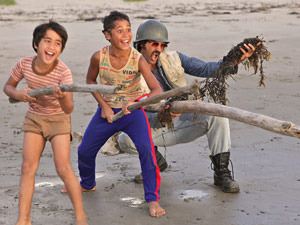
Publicity Still from "Boy"
Recently I watched the NZ film Boy on dvd, which I enjoyed, but at the end of the film I was struck by how much, both in this film and in a whole line of NZ films I've seen, the stories are focused around people who are—not to put to fine a point on it—losers. The father, in the case of Boy, but there are many more that spring to mind: Eagle vs Shark; Apron Strings; Via Satellite; Scarfies—all the way back to Goodbye Pork Pie.
There's also our most successful recent export, the tv series Flight of the Conchords, where it's hard to argue that the three central characters are anything but losers.
I have to say, it's got me thinking, wondering what it is that leads us to focus on, even celebrate, the loser when we hold up the mirror of film to our culture and society? Is this really how we see ourselves—although it doesn't seem to fit with our approach to sport, for example. Or is it just another form of cultural cringe writ large?
I don't have any answers yet—am more just struck by having recognised what I perceive as a theme, but thought it worthwhile putting the observation out there and seeing what others think. Do you agree or diagree? Do you have any rationales to offer? And do you think we are starting to move past the "loser" phase with films like Dean Spanley and The Vintner's Luck. But then again, you could argue that these are not precisely NZ stories … so does the different focus just underline my theme?
I'd be fascinated to hear your thoughts.
November 5, 2010
Partial Solar Eclipse
I haven't done an "astronomy" post for a while, but I loved this shot—a NASA Picture of the Day from mid-October—which shows a partial eclipse of the sun by the moon, as seen from space. By the way, sharing cool photos like this is about as far as my "astronomy" goes, but I hope you get the same buzz out of them as I do.
And since we couldn't have fireworks here in Christchurch last night, due to rain, I thought having the sun on the blog might do by way of substitute! 
November 4, 2010
Great Things Happening for Christchurch Poets
Great things are happening for Christchurch poets this week:
Victoria Broome's first individual collection, Big Red Engine, has been shortlisted for the prestigious Kathleen Grattan Award, which is New Zealand's richest poetry prize. I interviewed Victoria on Women on Air, Plains 96.9 FM earlier in the year and very much enjoyed the poems she read then, so will have my fingers crossed for Victoria ahead of the announcement of the winner on November 21.
Victoria's second collaborative anthology, which has been put together with her four fellow poets—Catherine Fitchett, Barbara McCartney and Christina Stachurski—in the longstanding group The Poetry Chooks is being launched at South Libray this Saturday at 1 pm. The anthology is titled Flap: The Chook Book 2 and is being launched by well known poet and novelist Fiona Farrell.
—
A second Christchurch poet (also non-fiction author and academic), Jeffrey Paparoa Holman, has today been announced as the University of Waikato's Writer-in-Residence for 2011. Jeffrey plans to work on two projects during his year at Waikato: a new collection of poetry, working title Second Cuts, which will centre round New Zealand's shearing culture; and a memoir which stems from a photograph of a Kamikaze pilot striking an aircraft carrier with Holman's father on board.
Jeffrey—who is a fellow member of the Tuesday Poem Blog—is also launching a collection of poetry titled Fly Boy (Steele Roberts), on poems of flight, on Sunday 14 at The Air Force Museum of New Zealand.
—
It's certainly nice to see the book and poetry postives starting to happen again as we deal with the aftermath of our "earthquake spring!"
November 3, 2010
Favourite Cover Art
Recently, I did a guest spot on Out of this Eos blog, talking about why I loved both my covers for The Heir of Night (here), and then in the interview on Over the Edge Books, Christine asked me about favourite covers, which got me thinking …
… a process that was re-sparked today when I saw a trailer for the HBO version of George RR Martin's A Game of Thrones (which you, too, can check out here.) It looks great, I have to say, very atmospheric—and includes the chilling catchline that is the motto of the Starks, the central family in Martin's "A Song of Ice and Fire" series: Winter is Coming!
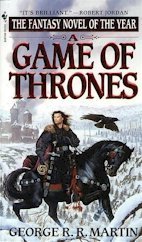
A Game of Thrones: Steven Youll cover
The reason that put me in mind of covers again is because one of my all time favourites is the Del Rey paperback cover by Steven Youll for A Game of Thrones. I remember the first time I saw it, clear across the room in the (now, sadly, gone) Bag End Books in Dunedin—and the whole look of it just reached out to me and said: "Buy me, I'm your kind of story!" And it really was! The cover both spoke for the book and was true to the book in a really powerful way.
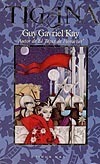
Tigana: Spanish cover
The Mel Odom cover for Guy Gavriel Kay's Tigana is quite different: stylised rather than realistic. It's formality reminds me of a Renaissance-era tapestry, which is appropriate for the book, and yet also speaks to what I call the "High Fantasy Romantic" nature of the story. In this case I already knew the author's work, because I had read and enjoyed The Fionavar Trilogy previously. Nonetheless, the Mel Odom cover was still a compelling factor in drawing me to Tigana. I have the US edition, but my favourite version of the Mel Odom cover appears in the Spanish edition, where it was (according to the author's website, Bright Weavings): "incorporated into a new design by Víctor Viano."
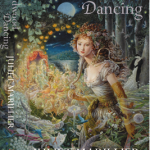
Wildwoond Dancing: Kinuko Craft cover

Moribito: Kinuko Craft cover
As I said in the Over the Edge interview, when it comes to cover art, I love just about anything I've ever seen by Kinuko Craft. Particular examples include her Wildwood Dancing cover for Juliet Marillier; the Japanese-styled cover for Nahoko Uehashi's Moribito: Guardian of the Spirit; and her many covers for novels by Patricia McKillip—although I think Od Magic is probably my favourite. Anyway, because I love these covers so much, I'm including both Wildwood and Moribito here. This also (imho) highlights the versatility of Craft's work.
So how about you—what are your favourite book covers? What cover has made you buy the book—and did the story live up to the cover's promise?




